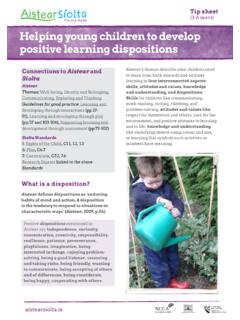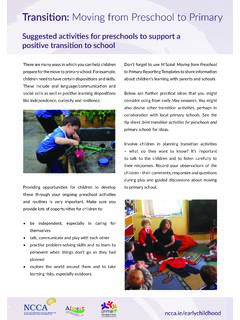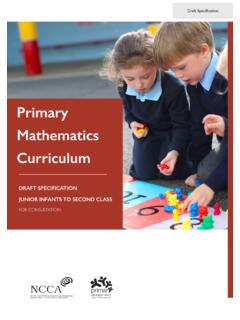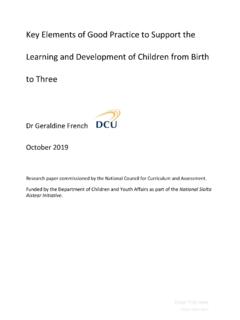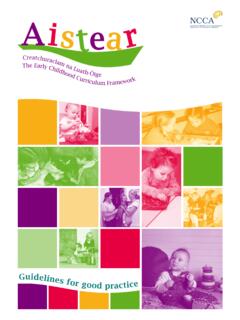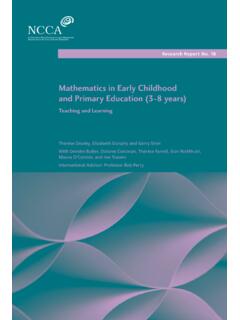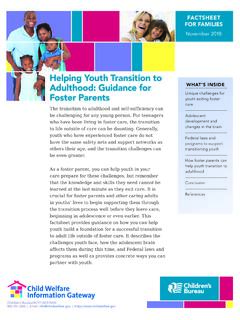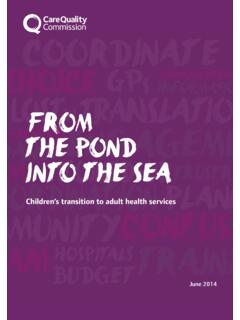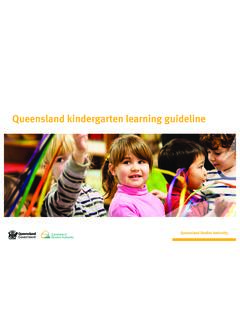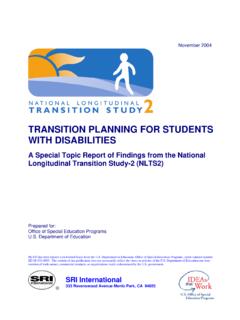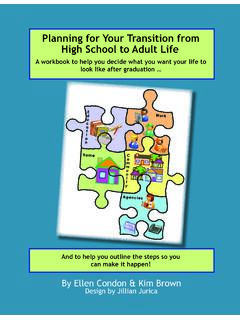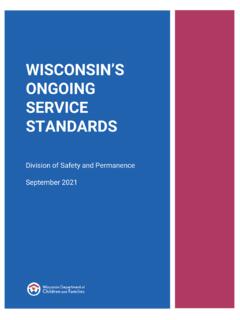Transcription of Guidelines - NCCA
1 Guidelinesfor Teachers of Students with General Learning DisabilitiesIntroductionIntroduction 3 Assessment 17 Communication and language 12 School and classroom planning 4 Managing challenging behaviour 37 Supporting teaching and learning 24through ICTC ontentsIntroduction This is a companion document to the Guidelines for Teachers of Students with General Learning Disabilities. Its primary purpose is to look at some of the wider issues that affect the teaching and learning of these students. As with the Guidelines themselves, it is intended for use by all teachers, and should also be accessible to a range of other personnel directly involved with the student s education, whether in mainstream primary and special primary schools, post-primary schools, or other educational settings. The introduction is divided into five sections:Section 1: School and classroom planningThis section looks at the key elements in school planning for inclusion of students with general learning disabilities.
2 Information on classroom planning explores the many different ways to differentiate teaching and learning. Section 2: Communication and language This section looks at the issues around communication and language development, and explores the common causes and conditions of language 3: Assessment This section outlines various methods of assessment and looks at the different ways they can be used to construct a detailed picture of the student s learning needs and 4: Supporting teaching and learning through ICTThis section looks at various ways ICT can facilitate and increase access to learning and communication for students with general learning 5: Managing challenging behaviourThis section addresses the main issues relating to challenging behaviour and outlines the various stages in planning an General Learning Disabilities / Introduction / Guidelines General Learning Disabilities / Introduction / School and classroom planning Section 1 School and classroom planning School planningEffective whole school planning is essential to ensure that the learning needs of all students are identified, adequately resourced and responded to effectively.
3 At the centre of this planning process is the student as a person and as a learner. School planning is an on-going process in which policies and plans respond to the changing and developing needs of learners. The important role that school planning plays in promoting school effectiveness has been stated in the Education Act , 998. A suggested model for school planning involvesreviewing existing curriculum delivery in light of its strengths and weaknesses designing school plans and strategies which detail how the curriculum content, teaching methods and resources can be used to meet the learning needs of all students, including students with general learning disabilitiesoutlining a course of action to support teachers in meeting the students learning needs reviewing and assessing at regular intervals whether the goals outlined in the school plan are being achieved. The school plan outlines the way in which teachers can work together in planning and adapting the curriculum to meet the students individual learning needs.
4 Facilitators from the School Development planning Support (SDPS) primary, are available to assist primary schools in addressing their self-identified planning priorities, including curriculum and/or organisational issues. Similarly, the School Development planning Initiative (SDPI) post-primary, offers information, Guidelines and resource materials to support the process of development planning in post-primary schools. Embracing new content, changes of emphasis, teaching approaches and methods, presents a challenge to schools. The commitment to providing students with special educational needs with an integrated educational experience in mainstream schools has added a further dimension to the range of curriculum provision required in primary and post-primary schools. Managing effective planning in mainstream or special schools in this context involves decisions in the selection of starting points and appropriate areas for development.
5 Where students are integrated in mainstream settings, it is important that the school s policy on inclusion is part of the school plan. The need for communication with parents /guardians and other relevant personnel should also be a feature of the plan. Professional development of staff School staff face a range of particular challenges when working with students with special educational needs and ongoing professional development plays an important role in assisting staff in meeting those challenges. As well as working with parents /guardians, the class teacher may liaise with professionals from other disciplines such as educational psychologists, speech and language therapists, visiting/resource teachers, occupational therapists, physiotherapists and Special Educational Needs Organisers (SENOs). Teachers will often be working with multidisciplinary teams and need a clear understanding of the roles and views of other professionals and organisations.
6 In reviewing reports on students, teachers need to become familiar with medical and psychological terminology. Education Act ( 998), Department of Education and Science, Dublin: Stationery Office. nnnnIt follows that staff need certain knowledge and skills to work with students with special educational needs. Support for ongoing professional development through in-service training at primary and post-primary level is provided by the Special Education Support Service (SESS), The following activities may help support the professional development of staff:liaising with principals and teachers from other school settings to share ideas and expertise inviting guest speakers or staff members with expertise to address staff meetings or on designated curriculum development days encouraging staff to participate in continuing professional development in the area of special education including courses and conferencesencouraging staff to share strategies, ideas and experiences with colleaguesorganising training for special needs assistants and any new groups of support staff as sanctioned by the Department of Education and Science or the Board of Management identifying and sharing useful websites establishing a section on special educational needs in the school with special needs assistants (SNAs)The special needs assistant is a vital member of the school team, and can make a valuable contribution to the educational experience of students with special educational needs.
7 It is important that teachers work closely with the special needs assistant and provide him/her with a sense of direction. The school plan outlines the role and responsibilities of the special needs parents /guardians Establishing good working relationships with parents /guardians is a key element in meeting the educational needs of all students. planning successful learning experiences for students with general learning disabilities will benefit greatly from the input of parents /guardians. parents /guardians can provide a wealth of information about their child and by following the approaches taken in school, particularly in relation to reading, writing and mathematics, parents /guardians can help to practise and reinforce new skills at home. Schools can refer parents /guardians to the NCCA s DVD The What, Why and How of Children s Learning in Primary School , which shows parents how they can support their child s learning at home during the years of primary schooling.
8 Where behaviour problems exist, it is important to ensure consistency in management between home and school. parents /guardians can often shed valuable light on the nature of a student s behaviour problem. This is valuable information that needs to be taken into account in any strategy developed to address inappropriate behaviour. planning for transition from primary to post-primary educationThe focus of planning for transition should be on preparing for change before it happens. Three phases can be identified in this process of planning for the transition of students with general learning disabilities from primary to post-primary education: Communication, Consultation, and General Learning Disabilities / Introduction / School and classroom planning CommunicationOngoing contact between the schools involved, whether mainstream primary schools or special schools, and the post-primary mainstream school is vital. This contact may be part of ongoing liaison with feeder primary schools.
9 The SENO, in communication with the principal, parents , and with support from the National Educational Psychological Service (NEPS), will plan how best to support the transition and help the school to prepare to meet the learning needs of students prior to their arrival in the Once the school becomes aware that a student with general learning disabilities will be transferring from a primary or a special school, a process of consultation needs to take place to gather information about the learning and other needs of the student. This information may be sourced from Individual Education Plans (IEPs), NEPS assessment reports, from parents /guardians, from social services where relevant, and from the school from which the student is transferring. In consultation with the SENO, the support, time, resources and personnel that have been available to date can be ascertained and the support which will be available to the school for the student beginning junior cycle can be planned for.
10 Other considerations at this stage of the planning process could includethe possibility of developing a buddy system for first year students use of withdrawal and in-class support as appropriate sharing of information and feedback between learning support staff and other staff involved how homework can be supportedbuilding in time to communicate with personnel in this phase include all staff with responsibility for special education and those with particular responsibility for first year students (tutor or year head). Towards the end of this stage, all teaching and ancillary staff that will be in contact with the student in their first or subsequent years in post-primary school should be informed and involved. ConsolidationThis third phase involves the bringing together and co-ordination of the relevant aspects of the school plan and ensuring that the desired outcomes are achieved prior to the arrival of the student in the school.
